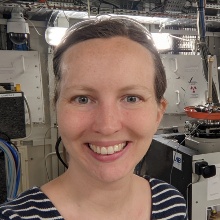We are pleased to announce that Catrin Harris from the Imperial College London (UK) will give the SFB 1313 "Pretty Porous Science Lecture" #46. Her talk will be on "Gas trapping dynamics in heterogeneous sandstones imaged using synchrotron time-lapse tomography".
Date: Tuesday, 17 October 2023
Time: 4:00 pm CET
Speaker: Catrin Harris, Imperial College London (UK)
Lecture title: "Gas trapping dynamics in heterogeneous sandstones imaged using synchrotron time-lapse tomography"
Place: Multi Media Lab (MML), U1.003, Pfaffenwaldring 61, 70569 Stuttgart, Campus Vaihingen. If you are interested in participating in the lecture, please contact melanie.lipp@iws.uni-stuttgart.de
Abstract
The ability to characterise and model capillary trapping in complex geological systems is essential to minimise risks and ensure permanence of geological carbon storage. Capillary trapping is impacted by cm-to-m scale layered rock heterogeneities, resulting in meso-scale capillary heterogeneity trapping. This has the potential to significantly improve the security of CO2 storage in underground aquifers by immobilizing a large proportion of the injected CO2.
Synchrotron-based X-ray micro-CT experiments at the European synchrotron (ESRF) were performed to investigate flow dynamics and transient trapping in heterogenous sandstone cores. The high energy of the ID19 beamline at ESRF allowed us to capture frontal advance and trapping at pore-scale resolution (6.5 microns) with a field of view over the continuum core scale (6 cm). Time resolution of 3 minutes allowed unsteady state displacements to be observed. We captured dynamically both drainage and subsequent imbibition, proceeding until the residual saturation was reached, gaining an understanding into the pore-scale fluid dynamics that control larger scale heterogeneity trapping.
Experimental results demonstrate the impact of cm-scale heterogeneity on pore-scale processes, which in turn influence large scale behaviour. Saturation distributions are compared for different heterogeneity types and flow rates, and the results correlated to the differential pressure response. Heterogeneity is shown to have a leading order impact on saturation distribution and storage capacity during geological CO2 storage. Such experimental observations resolving trapping over pore networks are crucial for model validation, development and ultimately storage predictions.


